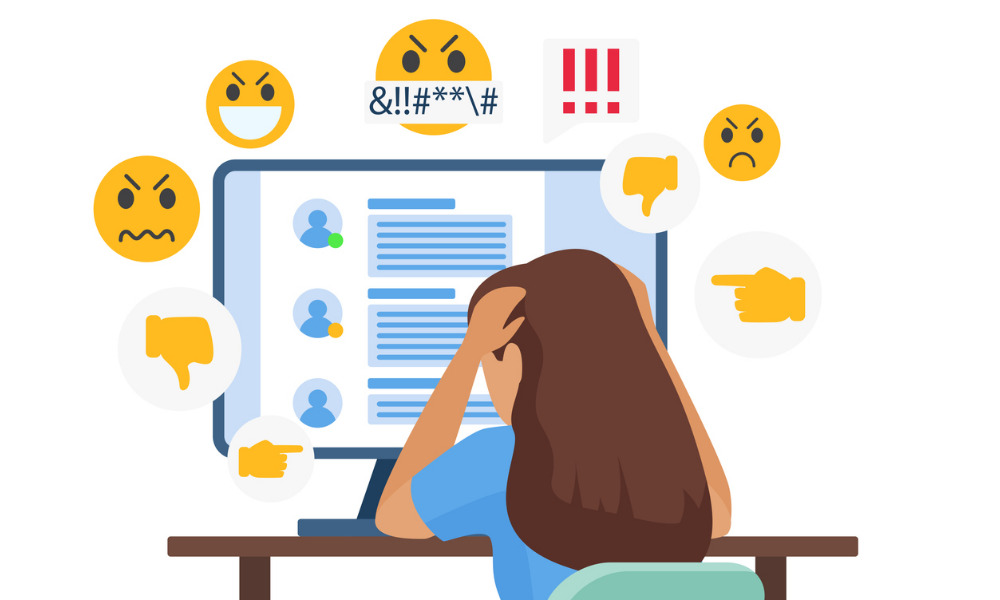
76% of leaders are worried about both online and in-person abuse in their organizations

What do we mean when we talk about harassment at work? The truth is that the definition has evolved – in no small part thanks to the COVID-19 pandemic.
Once, our idea of harassment in the workplace focused on verbal, in-person bullying, blatant physical or sexual abuse, and unwanted, unwarranted attention. Now, as the world pivots to a more hybrid work model and employees continue to work from their homes, harassment has taken on another dimension. A recent poll taken by UKG found that harassment and bullying were the most concerning areas of misconduct for HR professionals, with 76% of leaders worried about both online and in-person abuse.
Read more: Homework, bingo, and movies: Employees reveal bad 'remote work' habits
Harassment in a hybrid working model may be more subtle but make no mistake: it’s just as toxic and just as illegal. HRD recently spoke to Stuart Rudner, employment lawyer and founder of Rudner Law, who talked us through the legal pressure points of online harassment.
The classic definition of harassment, as seen in Ontario’s Occupational Health and Safety Act, is “engaging in a course of vexatious comment or conduct against a person in a workplace that is known or ought reasonably to be known to be unwelcome.” Now, as people continue to work from home, harassment has taken on an online form – namely, social media abuse and electronic bullying. For instance, we’ve seen a rise in toxic WhatsApp messaging, bullying posts on a colleague’s Facebook wall, etc. – mainly because that’s how we communicate now. We’re relying more on digital interactions which has inevitably led to a spike in digital harassment.
Say an employee has a bad experience in a video call – perhaps their manager is aggressive – if it’s a one-off, then it’s not harassment. However, if it continues and becomes a pattern, then it’s harassment. In remote work scenarios, many employers are relying on internal messaging systems to communicate with employees, which tend to be very informal. This casual tone leaves room for interpretation in comments and conversations – causing some people to commit forms of unintentional electronic harassment. Even excluding people from meetings or events can constitute bullying.
Harassment, whether it be in person or online, falls under the regulations of provincial Occupational Health and Safety. In many provinces, this means employers have a duty to make all reasonable efforts to provide a safe work environment, free from any form of abuse. In remote work, an employee’s home office is their workplace – and there’s still potential for harassment. If an employee reports a case of harassment, the employer must act quickly and decisively. Failure to do so, as we have seen in many cases, can leave the employer open to substantial liability – not to mention public scrutiny. Even if the misconduct takes place away from the office, is online, or is perpetrated by a third party like a customer or supplier, the employer’s duties are triggered.
Read more: Politics and respect at work in election season
Before any allegations arise, employers must update their policies to make sure that they refer to not only harassment but harassment in all its forms, including digital. This is mandatory in Ontario and many other jurisdictions – so internal reporting mechanisms must be easy to use and up to date.
Employers have a positive duty to investigate harassment, even if there is no formal complaint, if one of the people involved resigns, or if the complainant does not want them to. An investigation must be fair and impartial. The investigator’s job is to decide, on a balance of probabilities, whether there was harassment or not. Failing to investigate properly will expose the organization to liability.
This feature was released as part of UKG’s exclusive magazine. Discover what HR teams can expect from 2022 and beyond and learn strategies for the new era of work here.